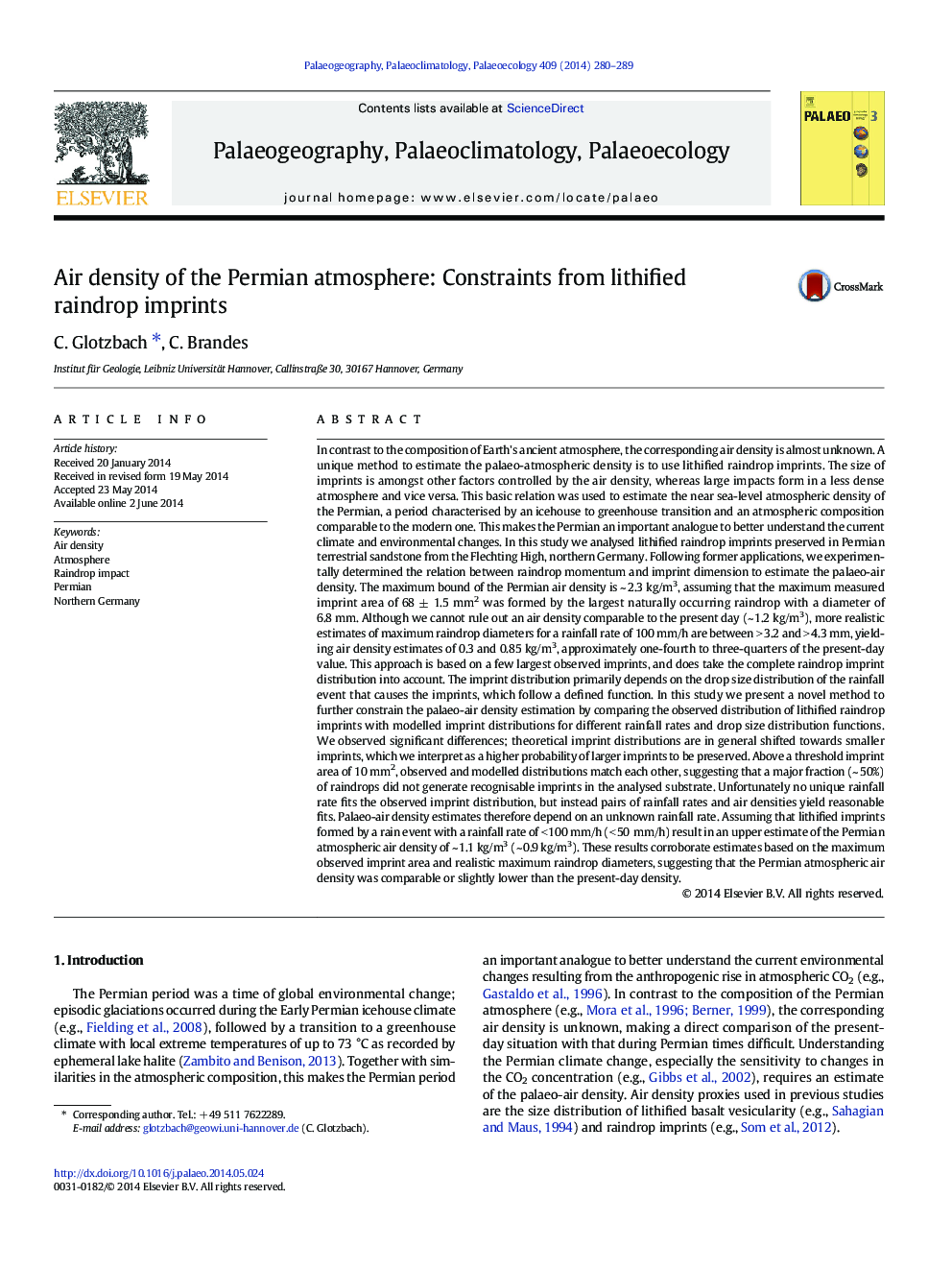| کد مقاله | کد نشریه | سال انتشار | مقاله انگلیسی | نسخه تمام متن |
|---|---|---|---|---|
| 6350112 | 1622181 | 2014 | 10 صفحه PDF | دانلود رایگان |
- Estimating Permian atmospheric density based on lithified raindrop imprints
- Permian atmospheric density was at maximum 2.3Â kg/m3.
- More likely values are <Â 1.1Â kg/m3, comparable or lower than the modern density.
- Comparing lithified imprint and drop size distributions has strengthened the results.
In contrast to the composition of Earth's ancient atmosphere, the corresponding air density is almost unknown. A unique method to estimate the palaeo-atmospheric density is to use lithified raindrop imprints. The size of imprints is amongst other factors controlled by the air density, whereas large impacts form in a less dense atmosphere and vice versa. This basic relation was used to estimate the near sea-level atmospheric density of the Permian, a period characterised by an icehouse to greenhouse transition and an atmospheric composition comparable to the modern one. This makes the Permian an important analogue to better understand the current climate and environmental changes. In this study we analysed lithified raindrop imprints preserved in Permian terrestrial sandstone from the Flechting High, northern Germany. Following former applications, we experimentally determined the relation between raindrop momentum and imprint dimension to estimate the palaeo-air density. The maximum bound of the Permian air density is ~ 2.3 kg/m3, assuming that the maximum measured imprint area of 68 ± 1.5 mm2 was formed by the largest naturally occurring raindrop with a diameter of 6.8 mm. Although we cannot rule out an air density comparable to the present day (~ 1.2 kg/m3), more realistic estimates of maximum raindrop diameters for a rainfall rate of 100 mm/h are between > 3.2 and > 4.3 mm, yielding air density estimates of 0.3 and 0.85 kg/m3, approximately one-fourth to three-quarters of the present-day value. This approach is based on a few largest observed imprints, and does take the complete raindrop imprint distribution into account. The imprint distribution primarily depends on the drop size distribution of the rainfall event that causes the imprints, which follow a defined function. In this study we present a novel method to further constrain the palaeo-air density estimation by comparing the observed distribution of lithified raindrop imprints with modelled imprint distributions for different rainfall rates and drop size distribution functions. We observed significant differences; theoretical imprint distributions are in general shifted towards smaller imprints, which we interpret as a higher probability of larger imprints to be preserved. Above a threshold imprint area of 10 mm2, observed and modelled distributions match each other, suggesting that a major fraction (~ 50%) of raindrops did not generate recognisable imprints in the analysed substrate. Unfortunately no unique rainfall rate fits the observed imprint distribution, but instead pairs of rainfall rates and air densities yield reasonable fits. Palaeo-air density estimates therefore depend on an unknown rainfall rate. Assuming that lithified imprints formed by a rain event with a rainfall rate of < 100 mm/h (< 50 mm/h) result in an upper estimate of the Permian atmospheric air density of ~ 1.1 kg/m3 (~ 0.9 kg/m3). These results corroborate estimates based on the maximum observed imprint area and realistic maximum raindrop diameters, suggesting that the Permian atmospheric air density was comparable or slightly lower than the present-day density.
Journal: Palaeogeography, Palaeoclimatology, Palaeoecology - Volume 409, 1 September 2014, Pages 280-289
